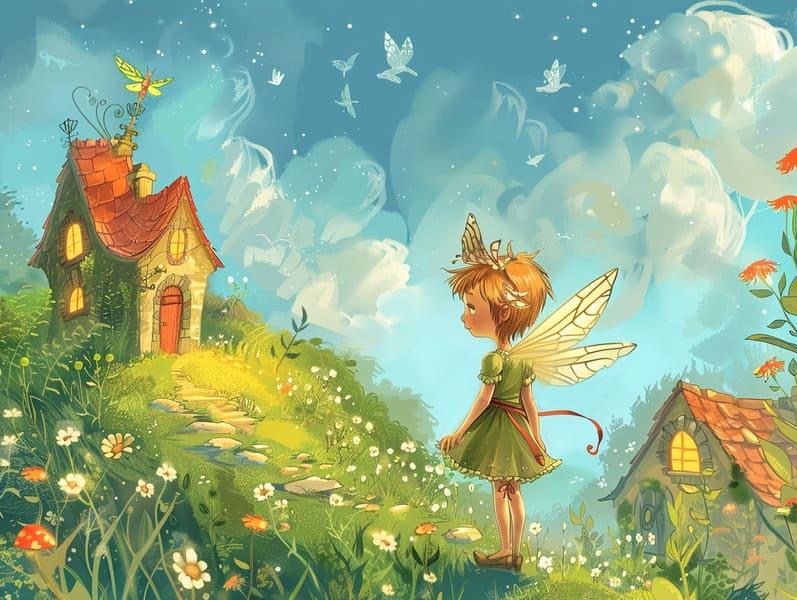
Short fairy tales have enduring presence. These narratives have been shared from one generation to the next well before they were ever transcribed. They were born from a variety of backgrounds, including European traditions. They were initially narrated among adults, often carrying themes and messages relevant to the societal norms and beliefs of the time.
Jacob and Wilhelm Grimm, Jacob and Wilhelm (the Grimm brothers), were among the first to collect and release many of these beloved fairy tales. Their collection, "Grimm's Fairy Stories," included stories like "The True Bride," "Hansel and Grethel," and "Snow-White and Rose-Red," which have since become pillars in the world of classic fairy tales. Similarly, Hans Christian Andersen's magical fairy tales, such as "The Little Mermaid," and "The Ugly Duckling," have gained the love worldwide, guaranteeing their place in the pantheon of iconic fairy tales.
Despite their age, fairy tales remain as pertinent as ever, especially as nighttime stories for kids. These enchanting tales are now available in multiple formats, including colorful picture books, enchanting animations, and online storybooks.
Their continued relevance can be attributed to several fascinating points:
Important Morals: Traditional fairy tales often provide important moral lessons. Stories like "The Shepherd Boy and the Wolf" teach the benefit of truthfulness, while "The Story of the Tortoise and the Hare" illustrate the traits of resolve and humility. These narratives offer little ones clear distinctions between virtue and vice, guiding their moral compass in a soft yet significant way.
Compassion and Insight: Traditional fairy tales frequently feature protagonists facing challenges and struggles, motivating kids to understand with their struggles and applaud their triumphs. For instance, "Beauty and Her Beast" shows us the significance of seeing inner beauty to recognize the true essence of a character, nurturing tenderness and insight.
Cultural Awareness: Many classic fairy tales are interwoven with the cultural contexts from which they grew. Understanding these fairy tales can provide captivating looks into different backgrounds, promoting a sense of cultural appreciation and comprehension.
Fantasy and Imagination: The mythical elements in timeless fairy tales—supernatural elements—inspire children’s visions. These narratives lead readers to fantastical realms, activating fantasy dreams and a sense of enchantment that persists a lifetime.
Old fairy tales are not only bewitching but also educational. They act as mesmerizing tools in strengthening various brain and heart skills in little ones. When classic fairy tales are told out loud, they enhance communication skills by teaching new words and complicated sentence structures. This practice also boosts auditory skills and focus, as little ones remain attentive, anticipating to see what happens next.
Furthermore, discussing the themes and characters of old fairy tales can foster thinking skills and reasoning skills. Kids are shown to find patterns, make predictions, and comprehend cause and effect. These explorations also support the young convey their thoughts and feelings, adding to their emotional intelligence.
In today’s digital era, the availability of free fairy tales online has made these fairy tales more available than ever. Internet resources and mobile apps give extensive collections of classic fairy tales that can be perused or listened to anytime, anywhere. Fairy tales voiced are particularly well-received, sharing an interactive method for children to experience these spellbinding stories. Read-aloud books and read-to-me videos lead characters and settings to life, often accompanied by entrancing background sounds and background music that intensify the storytelling experience.
The unfading fascination of traditional fairy tales lies in their ability to adjust to modern society while retaining their main lessons. Contemporary reimaginings of these stories often integrate more inclusive figures and modern settings, making them pertinent to today’s audience. However, the fundamental themes of fortitude, benevolence, and impartiality remain unchanged, continuing to touch kids of all ages.
Timeless fairy tales also offer a sense of protection and knownness. They extend a organized narrative with a straightforward beginning, middle, and end, often ending with the ending of conflicts and the triumph of good over evil. This constancy can be encouraging for the young, sharing a sense of firmness in an fluctuating world.
Old fairy tales continue to captivate and instruct new generations, maintaining their fascination and pertinence in modern society. As children's bedtime stories, they share a perfect blend of wonder and wisdom, encouraging moral values, empathy, and creativity. The proliferation of web-based fairy this site tales and the well-liked nature of fairy tales read aloud assure that these timeless stories remain within reach to new generations.
By keeping and releasing these fairy tales, we continue to appreciate the rich tapestry of lore and cultural heritage. Whether you are seeing a richly illustrated book, perusing a digital library, or listening to an audio story, the elegance of old fairy tales is always within reach. These tales illustrate of the enduring influence of storytelling and its ability to bring us together across epochs and places.
If you are delving into a vividly illustrated book, accessing a internet library, or listening to an audiobook, the radiance of Grimm's fairy tales is always within reach.
These narratives demonstrate of the unchanging presence of fairy tales and its ability to tie us across centuries and lands, forging a link that delights and instructs alike.
Comments on “The Beginning of Old Fairy Tales and Their Invariable Radiance.”